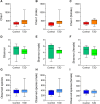In-depth Microbiological Characterization of Urine From Subjects With Type 2 Diabetes
- PMID: 38870276
- PMCID: PMC11651686
- DOI: 10.1210/clinem/dgae389
In-depth Microbiological Characterization of Urine From Subjects With Type 2 Diabetes
Abstract
Context: Lower urinary tract symptoms (LUTS) are common in type 2 diabetes (T2D), affecting quality of life and potentially leading to medication discontinuation. Among various factors contributing to LUTS, recent observations suggest a critical role of the urinary microbiota. Research on urinary dysbiosis in T2D remains underexplored.
Objective: We conducted a pilot study to investigate differences in the urinary microbiota between patients with T2D and healthy individuals and its potential indirect association with LUTS risk.
Methods: This case-control study included 50 patients with T2D and no LUTS, and 25 healthy controls. Microbial DNAs were extracted from urinary sediments and bacterial populations quantified by real-time quantitative polymerase chain reaction (PCR) and qualitatively investigated by 16S rRNA gene sequencing. Validation experiments with digital PCR were also performed.
Results: In patients with T2D a higher total bacterial load and an increased abundance of Bacillota were found. After stratification by gender, these results were observed only in women. However, no significant quantitative differences were observed at the genus level. Alpha diversity analysis showed no significant differences between T2D and control groups, or by gender. At the species level, a substantial qualitative and often gender-dependent shift was present in individuals with T2D.
Conclusion: The urinary microbiome of subjects with T2D was found to be different from that of healthy controls. Specifically, patients with T2D displayed higher total bacterial load and Bacillota levels, as well as qualitative changes in bacterial species. These changes suggested a dysbiotic condition of the urinary microbiota of subjects with T2D, with some gender-related differences. Although causality cannot be inferred, these findings highlight the impact of T2D on the urinary microbiota and its potential relevance in developing LUTS and, from a broader perspective, metabolic abnormalities.
Keywords: Bacillota; type 2 diabetes; urinary microbioma.
© The Author(s) 2024. Published by Oxford University Press on behalf of the Endocrine Society.
Figures



References
-
- Calogero AE, Burgio G, Condorelli RA, Cannarella R, La Vignera S. Epidemiology and risk factors of lower urinary tract symptoms/benign prostatic hyperplasia and erectile dysfunction. Aging Male. 2019;22(1):12‐19. - PubMed
-
- Papaefstathiou E, Moysidis K, Sarafis P, Ioannidis E, Hatzimouratidis K. The impact of diabetes mellitus on lower urinary tract symptoms (LUTS) in both male and female patients. Diabetes Metab Syndr. 2019;13(1):454‐457. - PubMed
MeSH terms
Substances
LinkOut - more resources
Full Text Sources
Medical

